Category E- Parking and stopping
 Sign E1 – No parking.
Sign E1 – No parking.
This sign only applies to the side of the roadway where this sign is placed.
If this sign is placed, you are allowed to park on the verge.
When this sign is placed, you are allowed to stop for a moment to let passengers get on and off. You can also load and unload goods here.
Vehicles may be parked on the other side of the road, provided this is not prohibited. In principle, signs are placed perpendicular to the road axis.
An exception has been made for this sign. These signs can be placed parallel to the road axis.
May or may not be provided with a bottom plate with an arrow pointing in the direction of the road section to which the ban applies.
On carriageways with traffic in two directions, this sign is placed in such a way that the prohibitions for traffic in both directions are visible.
For this purpose, the sign may be placed parallel to the road axis, provided it is provided with a bottom plate showing the start or end of the parking ban.
A bottom plate can indicate that the sign is only in effect during the days and/or hours indicated on the bottom sign.
Using a bottom plate, the sign can be declared applicable to certain vehicle categories, or it can be indicated to which categories the ban does not apply.
The sign can also be used as a zone.
The zone sign then indicates that it is prohibited to park within the zone, except on road sections intended for parking.
Since the sign applies to the side of the carriageway where the sign is placed, parking is (sometimes) allowed on the other side.In that case, take into account:
- Pedestrians, especially children, are playing. These can unexpectedly emerge between parked vehicles.
- Persons sitting in the vehicles. There is then a possibility that doors are opened without looking carefully. If there is the option to adjust your position on the road, do so. Try to drive out of the reach of the doors. You will probably be shocked if a door is suddenly opened, but you will not be directly affected.
- Drivers who drive from the parking position onto the road without first checking whether this is possible. If you see a driver sitting in a vehicle, take this into account.
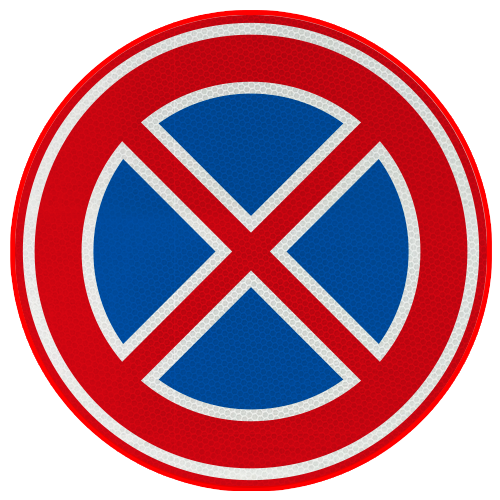 Sign E2 – Prohibition on standing still.
Sign E2 – Prohibition on standing still.
This sign only applies to the side of the carriageway where this sign is placed.
If this sign has been placed, you are allowed to stop on the verge.
If there are parking spaces after this sign, you may stop and park there.
At this sign, you are not even allowed to quickly get out of the car to post a letter. You are also not allowed to stop here to ask for directions.
Vehicles are allowed to stop and park on the other side of the road, provided this is not prohibited. In principle, signs are placed perpendicular to the road axis. An exception has been made for this sign. These can be placed parallel to the road axis.
It may or may not be equipped with a bottom plate with an arrow pointing in the direction of the road section for which it is prohibited to stand still. On carriageways with traffic in two directions, this sign is placed in such a way that the prohibitions for traffic in both directions are visible. For this purpose, the sign may be placed parallel to the road axis, provided it is provided with a bottom plate showing the start or end of the prohibition to stand still.
A bottom plate can indicate that the sign is only in effect during the days and/or hours indicated on the bottom sign. Using a bottom plate, the sign can be declared applicable to certain vehicle categories, or it can be indicated to which categories the ban does not apply.
Since the sign applies to the side of the carriageway where the sign is placed, parking is (sometimes) allowed on the other side.In that case, take into account:
- Pedestrians, especially children, are playing. These can unexpectedly emerge between parked vehicles.
- Persons sitting in the vehicles. There is then a possibility that doors are opened without looking carefully. If there is the option to adjust your position on the road, do so. Try to drive out of the reach of the doors. You will probably be shocked if a door is suddenly opened, but you will not be directly affected.
- Drivers who drive from the parking position onto the road without first checking whether this is possible. If you see a driver sitting in a vehicle, take this into account.
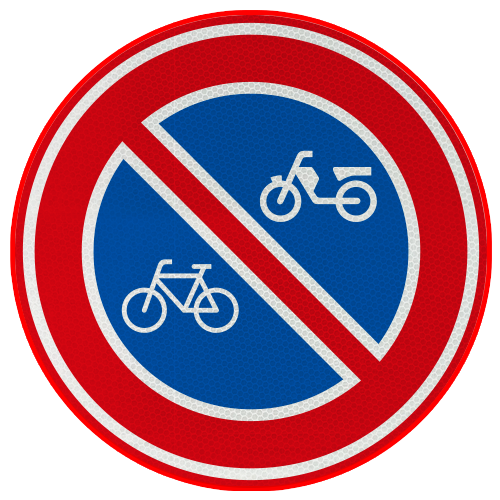 Sign E3 – Prohibition on parking bicycles and mopeds.
Sign E3 – Prohibition on parking bicycles and mopeds.
This sign only applies to the side where it is placed.
There is usually a bicycle shed in the area.
This way you can still park your bicycle or moped. You often find this sign at station squares and shopping promenades.
This sign is often placed as a zone sign.
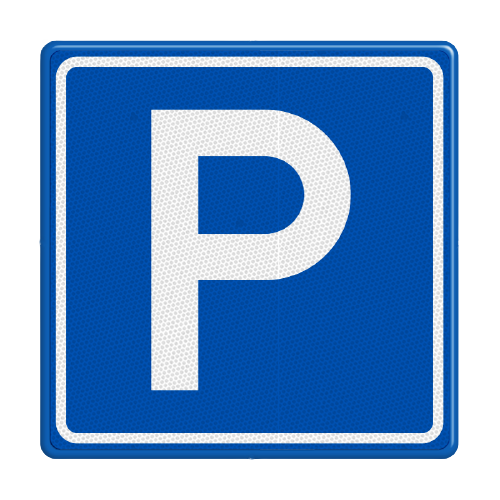 Sign E4 – Parking place.
Sign E4 – Parking place.
This sign indicates a parking area.If there are parking spaces, you must park in these spaces.
You can see this sign both inside and outside built-up areas, autowegen, and parking lots along motorways.
A maximum parking duration can be indicated using a bottom plate, or specific times can be indicated at which parking is permitted.
On roads outside built-up areas and autowegen, a bottom plate sometimes indicates that parking is located at a certain distance.
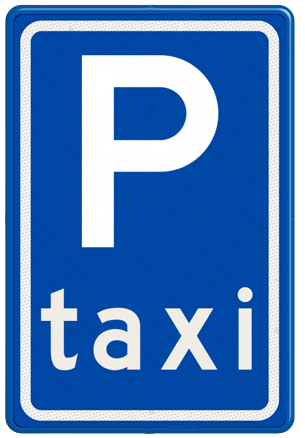 Sign E5 – Taxi stand.
Sign E5 – Taxi stand.
This sign has been placed to indicate one or more taxi stands. Public transport is often available in the vicinity of a taxi stand.
If there are parking spaces, you must park in the spaces.
A bottom sign can indicate that the parking facility is only intended as a taxi stand during the indicated days and/or hours. Outside the indicated periods, other vehicles are allowed to park here.
Take passengers boarding and disembarking into account.
Take into account the often hurried behavior of taxi drivers.
When driving away from the taxi stand, taxi drivers often enforce priority.
You may stop at a taxi stand to let a passenger get in or out. You can also stop here to load or unload goods.
 Sign E6 – Disabled parking space.
Sign E6 – Disabled parking space.
The term disabled parking space distinguishes between a disabled parking space “for general use” and “on a license plate”.
Cars may park in a disabled parking space for general use provided that a disabled parking card is clearly visible behind the window.
Vehicles for disabled persons are allowed to park here without having a disabled parking card clearly visible behind the window.
These parking lots are usually close to shopping centers and other busy places, such as zoos, hospitals, and the like.
A disabled parking space with a license plate is a parking space where only the car of a disabled person with a certain license plate may be parked. Disabled people are often unable to travel long distances from their car to their home or work location. They can then request their own parking space from the municipality.
If someone has a disability of a permanent or progressive nature, this person may be eligible for the disabled parking card. The disability must be determined by a medical examination by the GGD. The disabled parking card is valid for five years and applies throughout Europe. With the disabled parking card, a distinction is made between a driver’s card and a passenger card.
A driver’s card is only valid if the disabled person drives the car himself. If the person is dependent on others for transportation, the person can apply for a passenger card.
With this disabled parking card, you can park in a general disabled parking space. A disabled parking card allows you to park for three hours in a place where parking is prohibited. With a disabled parking card, you are exempt from paid parking in some municipalities.
You may stop in a disabled parking space to let a passenger get in or out. Standing still for loading and unloading is also permitted here.
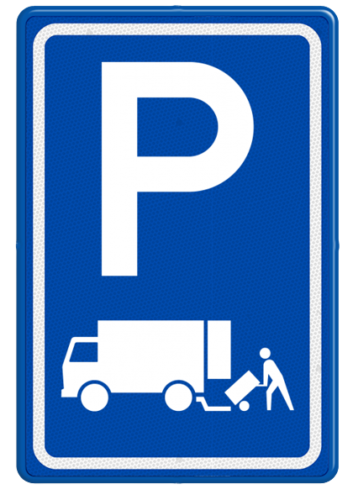 Sign E7 – Facility intended for immediate loading and unloading of goods.
Sign E7 – Facility intended for immediate loading and unloading of goods.
At a location indicated by this sign, loading, and unloading is only permitted by vehicle drivers. Despite the image of a truck, this sign also applies to other vehicles.
Parking is prohibited at this sign.
This sign is often placed in shopping streets or near shopping centers. Without these signs, it will otherwise be difficult to supply the adjacent shops.
In a parking lot with this sign, parking is only allowed in the spaces (if present).
Pay attention to the driver and any co-driver who can walk around the car or truck.
You may also stop at this sign to let passengers get on or off.
 Sign E8 – Parking reserved for the vehicle category or group of vehicles indicated on the sign.
Sign E8 – Parking reserved for the vehicle category or group of vehicles indicated on the sign.
Only the vehicles depicted on the sign may park in these parking spaces. A parking ban applies to the other vehicle categories.
The image of the car on the board is an example. Symbols of buses, trucks, motorcycles, and the like can also be depicted on the sign.
In a parking lot with this sign, parking is only allowed in the spaces (if present).
Stopping for the immediate boarding and disembarking of passengers or the loading and unloading of goods is also permitted for other categories of vehicles than those indicated on the sign.
 Sign E8a – Parking reserved for campers only
Sign E8a – Parking reserved for campers only
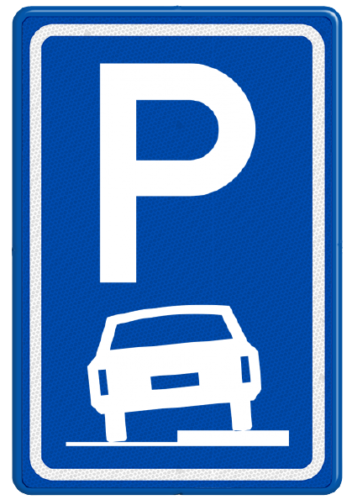 Sign E8b – Parking for two-wheel parking on the sidewalk.
Sign E8b – Parking for two-wheel parking on the sidewalk.
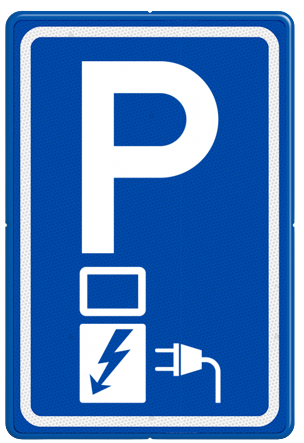 Sign E8c – Parking only intended for charging electric vehicles.
Sign E8c – Parking only intended for charging electric vehicles.
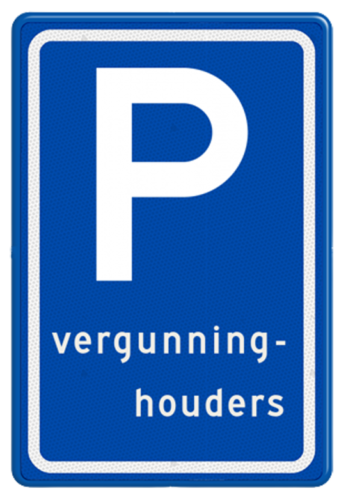 Sign E9 – Parking for permit holders only.
Sign E9 – Parking for permit holders only.
You are only allowed to park in these parking spaces if you have a valid parking permit for these parking space(s). Parking is prohibited for other vehicles.
In a parking lot with this sign, parking is only allowed in the spaces (if present).
You may stop here to let a passenger get on or off. Standing still for loading and unloading goods is also permitted here.
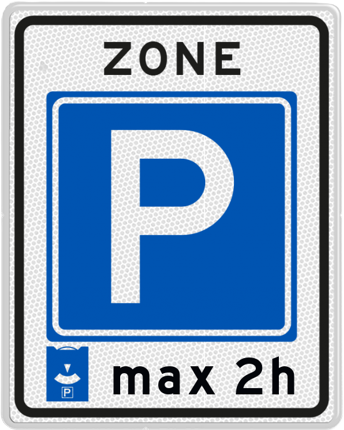 Sign E10 – Parking disc zone with mandatory use of a parking disc, also parking is prohibited if parking is longer than the parking duration indicated on the sign.
Sign E10 – Parking disc zone with mandatory use of a parking disc, also parking is prohibited if parking is longer than the parking duration indicated on the sign.
In a parking disc zone, you may only park in parking spaces along the blue line or the parking spaces designated as such, provided you have placed a clearly visible parking disc stating the time of arrival. The end of the permitted parking period must not have passed.
You may not set a different time again afterward without actually participating in traffic with the vehicle in question!
A parking disc zone is also called a “blue zone”. The origin of this name is clear. There is always a blue stripe.
The obligation to place a parking disc only applies to motor vehicles with more than two wheels. So also for brommobielen and motorcycles with sidecars.
Motorcycles may park without a parking disc.
Motor vehicles with a valid disabled parking card and disabled vehicles may park without restriction in a parking disc zone. The use of a parking disc is not mandatory for them.
The 2-hour parking duration on the sign is an example. A different parking duration may also be shown on the sign.
You may stop here to let a passenger get on or off. Standing still for loading and unloading goods is also permitted here.
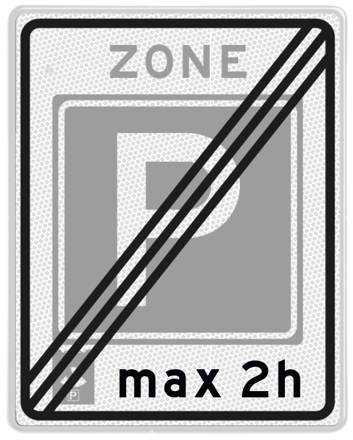 Sign E11 – End of parking disc zone with mandatory use of parking disc.
Sign E11 – End of parking disc zone with mandatory use of parking disc.
After this sign, the parking disc zone ends. Parking is now allowed again in the normal places, according to the normal rules.
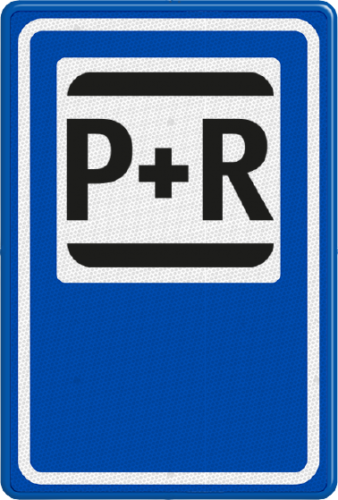 Sign E12 – Parking for public transport users.
Sign E12 – Parking for public transport users.
These parking spaces are located at train or bus stations. You can park your car here and then continue traveling by public transport.
In a parking lot with this sign, parking is only allowed in the spaces (if present).
The parking must meet several requirements:
- The parking must contain at least 40 parking spaces.
- The parking must be provided with paving, a parking space layout and public lighting.
- A parking space at this parking facility may not be located further than approximately 250 meters walking distance from the public transport stop.
 Sign E13 – Parking for carpoolers.
Sign E13 – Parking for carpoolers.
These parking spaces are intended for carpoolers. Carpooling means that several employees drive to work in one car.
To reduce traffic jams, the idea of carpooling was introduced a while ago. The idea is that people meet at a certain point, for example, a carpool parking lot, and then continue to work together. This will result in fewer cars on the road. The result is that less fuel is used, the environment is protected and traffic jams become shorter.
In a parking lot with this sign, parking is only allowed in the spaces (if present).
